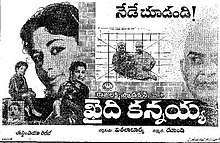Khaidi Kannaiah
Khaidi Kannaiah (transl. Convict Kannaiah) is a 1962 Indian Telugu-language crime film directed by B. Vittalacharya and produced by Pothina Doondeswara Rao. It is a remake of the Hindi film Qaidi No. 911 (1959) and its Tamil version Kaithi Kannayiram (1960). The film stars Kanta Rao, Rajanala Kaleswara Rao, Gummadi Venkateswara Rao, Relangi, Rajasulochana and Girija.
| Khaidi Kannaiah | |
|---|---|
 Poster | |
| Directed by | B. Vittalacharya |
| Produced by | Pothina Doondeswara Rao |
| Based on | Qaidi No. 911 by C. J. Pavri |
| Starring | Kanta Rao Rajanala Kaleswara Rao Gummadi Venkateswara Rao Relangi Rajasulochana Girija |
| Music by | Rajan–Nagendra |
| Cinematography | Chandru |
| Edited by | Govindaswamy |
Production company | Rajalakshmi Productions |
Release date |
|
| Country | India |
| Language | Telugu |
Plot
Kannaiah is robbed of the bank cash he was carrying by Paparao, a gangster who also kidnaps his motherless son Ravi with the help of his partner Ramu. Kannaiah is framed for the theft and arrested. In prison he learns that his son has died, and blames his sister-in-law Madhavi and her brother Ramu for the death. Kannaiah finds solace in the company of Raju, the son of the jailor. Padma is Raju's tutor. A dangerous criminal Durgarayudu kidnaps Raju and absconds from prison. Kannaiah escapes to save Raju and finds shelter in Padma's house. Singaram, a small-time thief and lover of Padma, joins him in his pursuit. The area's inspector captures Paparao. Kannaiah eventually locates Durgarayudu's hideout with the help of Padma, who wanders the streets singing the song she earlier taught Raju. The guilty is caught, Raju is saved, Kannaiah is exonerated and marries Madhavi.[1]
Cast
- Kanta Rao as Kannaiah[1]
- Rajanala Kaleswara Rao as Durgarayudu[1]
- Gummadi Venkateswara Rao as the jailor[1]
- Relangi as Singaram[1]
- Rajasulochana as Padma[1]
- Girija as Madhavi[1]
- Daisy Irani as Raju[1]
- K. V. S. Sarma as Paparao[1]
- Baby Suma as Ravi[1]
- Balakrishna as Ramu[1]
- K. S. Reddy as the inspector[1]
Production
Khaidi Kannaiah is a remake of the Hindi film Qaidi No. 911 (1959), written by C. J. Pavri. It was produced by Pothina Doondeswara Rao, presented by Sundarlal Nahata under Rajalakshmi Productions, and directed by B. Vittalacharya. The film, however, more closely followed Qaidi No. 911's Tamil version Kaithi Kannayiram (1960), except for the climax, which was re-written the way Vittalacharya pleased. Chandru and Govindaswamy were hired as cinematographer and editor respectively, while G. Krishnamurthy wrote the dialogues and lyrics. Rajasulochana and Daisy Irani, who appeared in Kaithi Kannayiram, reprised their roles in Khaidi Kannaiah, with Irani again being billed in the credits as "Baby Savithri". The climax was shot at Hogenakkal, Tamil Nadu.[1]
Soundtrack
The soundtrack was composed by Rajan–Nagendra.[2] The song "Teeya Teeyani Tenela Maatalato", sung by P. Susheela, is based on "Meethi Meethi Baton Se" from the Hindi original, and "Ee Nijam Telusuko", sung by P. B. Sreenivas and S. Janaki, is based on "Ek Sawal My Karun" from Sasural (1961). Two other songs were "Andaala Kalla Choodu" by Susheela, and "Premaku Kaanuka Kaavalena", sung by her and Madhavapeddi Satyam.[1]
| No. | Title | Lyrics | Singer(s) | Length |
|---|---|---|---|---|
| 1. | "Ee Nijam Telusuko" | G. Krishnamurthy | P. B. Sreenivas, S. Janaki | |
| 2. | "Chotekkada Chusedeppudu" | G. Krishnamurthy | P. Susheela | |
| 3. | "Theeya Theeyani Thenela Matalatho" | G. Krishnamurthy | P. Susheela, R. Rajasri | |
| 4. | "Yavvanam Adhi" | G. Krishnamurthy | P. Susheela, Chorus | |
| 5. | "Premaku Kanuka Kavalena" | G. Krishnamurthy | P. Susheela, Madhavapeddi Satyam | |
| 6. | "Andhala Kallu Chudu" | G. Krishnamurthy | P. Susheela | |
| 7. | "Theeya Theeyani Thenela Matalatho" (Pathos) | G. Krishnamurthy | P. Susheela, R. Rajasri |
Release and reception
Khaidi Kannaiah was released on 1 March 1962.[3] The film became a box office success, running for over 100 days in theatres.[1]
References
- Khaidhi Khanayya (songbook) (in Telugu). Rajalakshmi Productions. 1962.
- "Khaidhi Kanayya". Indiancine.ma. Retrieved 15 November 2018.